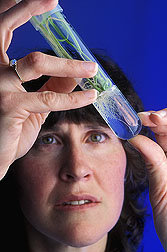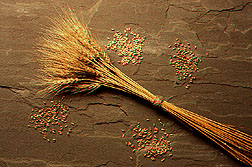This page has been archived and is being provided for reference purposes only. The page is no longer being updated, and therefore, links on the page may be invalid.
|
|
Making Wheat Flour More Nutritious
By Marcia Wood
November 24, 2006
Your favorite bread, breakfast cereal or pasta might tomorrow be made with wheat flour that's more nutritious than ever. Agricultural Research Service (ARS) and university scientists have identified a gene that can increase the protein, iron and zinc content of wheat kernels. The gene, known as Gpc-B1, does that in bread wheats and pasta wheats alike.
Today, nearly all Americans eat enough protein for good health, but more than 36 million of us don't get enough zinc, and more than 15 million are short on iron. The wheat research, by enriching the nutrients in one of the world's leading crops, holds the potential to improve Americans' health and that of millions of the world's malnourished.
Plant geneticist Ann E. Blechl helped prove the Gpc-B1 gene's prowess in enhancing wheat flour's nutritional bounty. She used a technique called "RNA interference" to lower what are known as the gene’s expression levels in wheat plants. Blechl did the work in her laboratory at the ARS Western Regional Research Center in Albany, Calif.
|
|
Collaborators working under the direction of wheat breeder and professor Jorge Dubcovsky of the University of California-Davis found that kernels harvested from the plants with lowered Gpc-B1 levels had at least 30 percent less protein, zinc and iron. According to Blechl, the work proved that Gpc-B1 controlled all of these nutrients. The finding predicts that incorporating additional copies of the functioning gene into bread and pasta wheats will be valuable.
Blechl is an international authority on the use of RNA interference and other biotech approaches to explore the largely untapped capabilities of genes of grain-bearing crops.
Dubcovsky, Blechl and colleagues in Haifa, Israel, report their findings in the current issue of the journal Science. A summary can be viewed on the World Wide Web by going to www.Sciencemag.org, then clicking on "current issue."
The research was sponsored by two U.S. Department of Agriculture agencies—ARS and the Cooperative State Research, Education and Extension Service—and the United States-Israel Binational Agricultural Research and Development Fund.
ARS is USDA's chief in-house scientific research agency.


